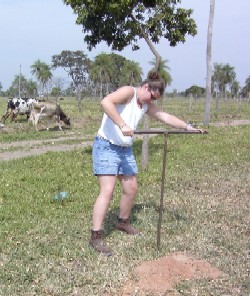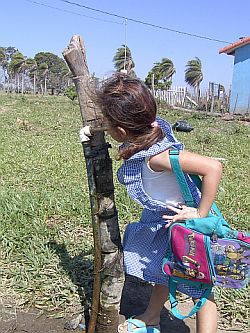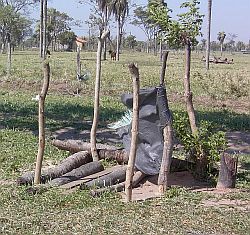
|
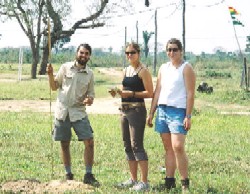
Team members
Equipo Septico
Team members:
Leslie DellAngelo, Communication Specialist & Drafting
Technician
Chris Fehrman, Project Manager
Kimberly Kimmes, Field Engineer & Drafting Technician
|
Water Quality
Testing and Alternative Wastewater Treatment Designs
Santa Cruz, Bolivia
CE 4905 Senior
Design Summer 2004
Slide Show Scenes of 2004 Projects
Team Mission
“Provide the Bolivian people with improved living conditions by
designing onsite wastewater treatment and providing water testing.”
|
|
Background
The District Seven public school system which are located on the eastern
perimeter of the city of Santa Cruz de la Sur, Bolivia. Four of District
Seven’s schools, Escuela Central Obrera Departamental, El Buen Samaritario,
the Escuela Fiscal Mato “Guapilo Junin”, and the Unidad Educativa
“4 de Febrero” are all located on the perimeter of the city,
just outside of the seventh ring. The roads are not paved and entire families
live in dilapidated, single room homes. The neighborhoods are serviced
by public buses, and the families can not afford personal means of transportation.
The school system provides the facilities and faculty necessary for primary
and secondary education. The District Seven schools have struggled with
government finances since the day they were established. These public
schools are located in low-class neighborhoods. The Bolivian government
does not pay for materials or labor for the construction of the school
buildings. Nor does the Bolivian government pay for repairs and maintenance
of the school buildings. The government is only responsible for the salaries
of the teachers and directors and for payment of utilities. The basic
utilities at most schools include drinking water and electricity. Many
of the faculty salaries are not high enough to support themselves and
their families. These teachers must hold other jobs outside of the public
school system in order to survive. At times, the schools go for months
without electricity because the government fails to pay electric bills.
|
Field Work
Topographic Surveying Soil Boring Groundwater table Percolation test Flow
determination
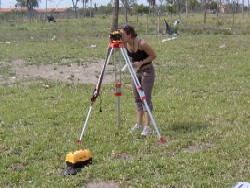
|
|
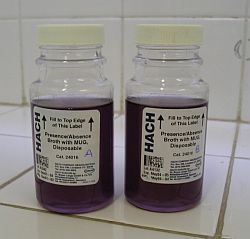
Water Testing Results
|
Water
Quality Testing
Objective
Verify water quality at schools
Methods and Procedures
- Collect water samples
- Inoculate 3M Petrifilm Enterobacteriaceae count plates
- Inoculate HACH P/A Broth Bottles
- Incubate at the Saguapac laboratory
Results
- P/A broth bottles tested negative
- Petrifilm plates indicate 0 cfu’s
|
|
4 de Febrero
School
- School is expanding from 5 classrooms to 7.
- Future school population of 515.
- Limited government funds for the facility
Problem
Failing Septic System
Project Objective
Design an improved or replacement and economical wastewater treatment
system that will accommodate the future school population of 515.
|
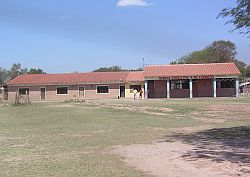
|
|
Design
Parameters
Depth to groundwater is 1.8 m
Average percolation rate is 1200 min/in
Design population is 515
|
Alternatives
Holding Tank
Advantages
- No onsite treatment
- Low maintenance
- Construction cost:
$US 700
Disadvantages
- Cost of pumping:$US
50/month
- Unfamiliar to
Bolivian people
Elevated
Mound System
Advantages
- Minimal excavation
- High quality effluent
Disadvantages
- High construction
costs: $US 5900
- Large footprint:
26,500 ft2
- Operational costs
Intermittent Sand
Filter
Advantages
- High quality effluent
- Low construction
costs
- Subsurface system
- Soil cover prevents
odor
- Minimal land use:
1430ft2
Disadvantages
- Regular maintenance
- Possible clogging
of filter
- Unfamiliar to
Bolivian people
|
Selected
Design: Alternative 3 – ISF with Dosing Tank and Siphon
Septic Tank
2 compartments
48-hr detention time
382 ft3 volume
Dosing Tank with Simple Siphon
Dosing Volume
56 gal
2” PVC Siphon
Intermittent Sand Filter Application rate: 1 gal/ft2/day Absorption area:
1430 ft2 24” of Sand Media 8 flush pipes
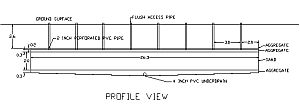
|
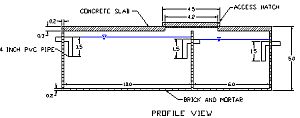
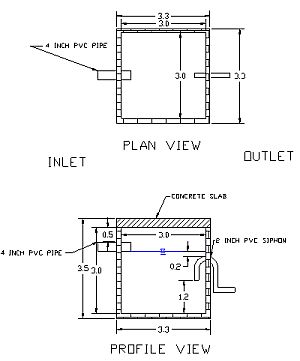
|
| Buen
Samaritano School
Problem: Inadequate
bathroom facility
Design Objectives
Effective
Economical
Design Parameters
Soil Type: Fine Sand
Groundwater Depth: 2.75 m
Percolation Rate: 3.63 min/in
Flow: 1030 gal/day
Design Alternatives.
Traditional Bolivian System:
Septic Tank with Seepage Tank
2. Conventional American System:
Septic Tank with Drainage Field
|
Alternatives
Alternative
1: Traditional Bolivian System
Advantages
- Familiar to Bolivian
people
- Low construction
cost $US 950
Disadvantages
- Groundwater contamination
- Treatment
Alternative 2:
Conventional American System: Septic Tank with Drainage Field
Advantages
- Effectively treats
domestic wastewater with sandy soils
- Low construction
cost of $US 670.22
Disadvantages
- Unfamiliar system
to the Bolivian people
- Septic tank requires
pumping more frequently due to higher solids removal.
- Drainage field
uses higher amount of the land area than a seepage tank
|
Recommended
Design
Septic Tank
- 2 compartments
- 36 hr detention time
- 5859 L Volume
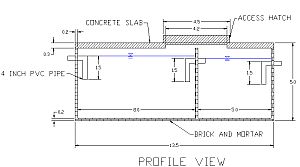
Distribution Tank -
484 L Volume
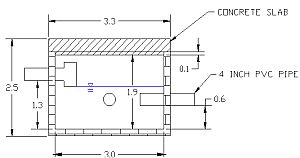 |
Drainage
field
Application rate of 2.70 gal/ft2/day
Absorption area of 382 ft2
3 parallel trenches 56 ft long and 3 ft apart
2 % slope
4” perforated PVC pipe
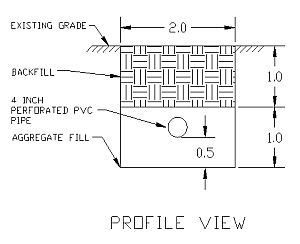 |
Conclusion
Although there was no coliform or bacterial contamination found at the sites,
drinking water quality remains of concern, especially with the potential
for untreated wastewater to contaminate the sources. Equipo Septico recommends
more comprehensive water quality testing be completed at the schools to
determine if the water meets the World Health Organization’s standards
of less than 1 colony forming unit per 100 milliliters of water.
The schools in District Seven of Santa Cruz are also seeking to develop
proper wastewater treatment systems. The Buen Samaritano School currently
has a hole in the ground for the children to dispose of their sanitary waste.
The 4 de Febrero School constructed a traditional Bolivian Septic System
three years ago that functioned for only 1 ½ years before failing.
After a series of modifications and failures, the school is in need of an
alternative design that will work for their site. Equipo Septico completed
a conventional US septic system design for Buen Samaritano School and an
Intermittent Sand Filter design for 4 de Febrero School. The proposed systems
should improve the sanitary conditions for the students and faculty at both
schools. The systems will be able to accommodate the increasing enrollment
of students at both schools and will further serve to minimize the contaminants
that could potentially reach the groundwater at these sites. |
| |
|
| |
Michigan Technological
University
Department of Civil and Environmental Engineering
1400 Townsend Drive
Houghton, Michigan, 49931 - 1295, USA
Department Phone: 1-906-487-2520
Department Fax: 1-906-487-2943
Department E-mail: cee@mtu.edu
© 2004 Michigan Technological University
The sale or commercial use of Illustrations, photographs and graphic images
presented on this site is not permitted. Educational uses are permitted,
provided credit is given to sources.
|
|

